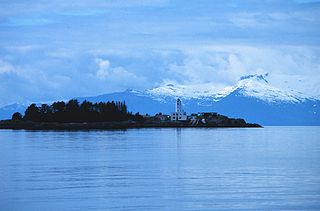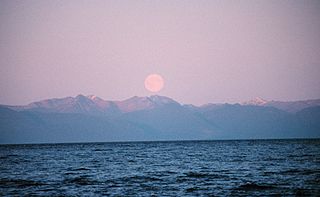Related Research Articles

Captain George Vancouver was a British officer of the Royal Navy best known for his 1791–95 expedition, which explored and charted North America's northwestern Pacific Coast regions, including the coasts of what are now the American states of Alaska, Washington, and Oregon, as well as the Canadian province of British Columbia. He also explored the Hawaiian Islands and the southwest coast of Australia.

Douglas Island is a tidal island in the U.S. state of Alaska. It is part of the city and borough of Juneau, just west of downtown Juneau and east of Admiralty Island. It is separated from mainland Juneau by the Gastineau Channel, and contains the communities of Douglas and West Juneau.

Frederick Sound is a passage of water in the Alexander Archipelago in Southeast Alaska that separates Kupreanof Island to the south from Admiralty Island in the north.

Chatham Strait, or Shee ya xhaak in the Tlingit language, is a narrow passage of the Alexander Archipelago in the southeastern region of the U.S. state of Alaska. It separates Chichagof Island and Baranof Island to its west from Admiralty Island and Kuiu Island on its east.

Admiralty Island is an island in the Alexander Archipelago in Southeast Alaska, at 57°44′N134°20′W. It is 145 km (90 mi) long and 56 km (35 mi) wide with an area of 4,264.1 km2 (1,646.4 sq mi), making it the seventh-largest island in the United States and the 132nd largest island in the world. It is one of the ABC islands in Alaska. The island is nearly cut in two by the Seymour Canal; to its east is the long, narrow Glass Peninsula. Most of Admiralty Island—more than 955,000 acres (3,860 km2)—is occupied by the Admiralty Island National Monument - a federally protected wilderness area administered by the Tongass National Forest. The Kootznoowoo Wilderness encompasses vast stands of old-growth temperate rainforest. These forests provide some of the best habitat available to species such as brown bears, bald eagles, and Sitka black-tailed deer.

Stephens Passage is a channel in the Alexander Archipelago in the southeastern region of the U.S. state of Alaska. It runs between Admiralty Island to the west and the Alaska mainland and Douglas Island to the east, and is about 170 km (105 mi) long. Juneau, the capital of Alaska, is near the north end, on Gastineau Channel.

Etolin Island is an island in the Alexander Archipelago of southeastern Alaska, United States at 56°05′52″N132°21′37″W. It is between Prince of Wales Island, to its west, and the Alaska mainland, to its east. It is southwest of Wrangell Island. It was first charted in 1793 by James Johnstone, one of George Vancouver's officers during his 1791-95 expedition. He only charted its southwest and east coasts, not realizing it was an island. It was originally named Duke of York Island but was renamed by the United States after the Alaska Purchase. It is named after Adolf Etolin, governor of the Russian American colonies from 1840 to 1845.
von Donop Marine Provincial Park, formerly Von Donop Marine Provincial Park, is a provincial park in British Columbia, Canada, located on the north end of Cortes Island in the Discovery Islands.

Lincoln Island is a wooded island in Lynn Canal in Alaska, United States. Located at 58°29′41″N134°59′40″W, the island is one kilometer northwest of larger Shelter Island and some 200 meters southeast of smaller Ralston Island. It is part of the Juneau City and Borough. The first European to sight the island was Joseph Whidbey, master of HMS Discovery during George Vancouver's 1791–1795 expedition, in 1794. It was named in 1868 by Commander R. W. Meade, USN, presumably for Abraham Lincoln.

Hole Rock is the largest of several rocks lying close north of North Foreland, the northeastly cape of King George Island, in the South Shetland Islands. It was charted in 1937 by Discovery Investigations personnel on the Discovery II and so named because a conspicuous hole extends through it.
Fillmore Island is an island in Southeast Alaska, United States. The island lies between Fillmore Inlet and Pearse Canal. The island was charted by George Vancouver in 1793, who sailed around it and proved its insular nature. It was named in 1885 by the U.S. Coast and Geodetic Survey after Ensign John Hudson Fillmore, USN.
Bell Island is an island in the Alexander Archipelago in Southeast Alaska, United States. It is 14 kilometres (8.7 mi) long, lying in Behm Canal, north of Revillagigedo Island. George Vancouver first visited the island on August 12, 1793, in the evening dining on its south coast. He suspected that it was an island, but this was not proven until later in the same month, when Joseph Whidbey, master of HMS Discovery, charted its entire coastline. Vancouver later named it "Bell's Island" after one of his crew, Midshipman Bell.
Affleck Canal is an inlet in Southeast Alaska, United States It extends 32 kilometres (20 mi) north from Sumner Strait, nearly cutting Kuiu Island in two. It was first charted in 1793 by Joseph Whidbey, master of HMS Discovery during George Vancouver's 1791–1795 expedition. Vancouver named it for Admiral Philip Affleck, RN.
Favorite Channel is a channel in Southeast Alaska, northwest of Juneau, Alaska, United States. It is 25 kilometres (16 mi) long, extending northwest from Stephens Passage to Lynn Canal, separating Lincoln and Shelter islands from the mainland to the east. It was named in 1880 by U.S. Navy officers after the 80-foot (24 m) steamboat Favorite, which was chartered by the Navy for surveying work in Alaska, later being used to carry out trading and fishing for the herring plant at Killisnoo. The first European to traverse and chart the channel was Joseph Whidbey, master of HMS Discovery during George Vancouver's 1791–95 expedition, in 1794.

Seymour Canal is an inlet penetrating deep into the southeastern part of Admiralty Island, Southeast Alaska, United States. The inlet was first charted in 1794 by Joseph Whidbey, master of HMS Discovery during George Vancouver's 1791–95 expedition. Vancouver later named it "Seymour's Channel". Two large islands are located within it: Swan Island to the north, and Tiedeman Island just to its south.

The Glass Peninsula is a peninsula extending southeast from Admiralty Island, between Seymour Canal and Stephens Passage, Southeast Alaska, United States. It was named by the United States Coast and Geodetic Survey for United States Navy Commander Henry Glass, who had made surveys in the area in 1881. It was first charted in 1794 by Joseph Whidbey, master of HMS Discovery, during George Vancouver's 1791–1795 expedition.
Tiedeman Island is an island in the Alexander Archipelago, east of Admiralty Island, about two-thirds up from the entrance of Seymour Canal, Southeast Alaska, United States. To its north is Swan Island. It was named by William Healy Dall of the U.S. Coast and Geodetic Survey, and published in the 1883 Coast Pilot. The first European to discover and chart the island was Joseph Whidbey, master of HMS Discovery during George Vancouver's 1791–1795 expedition, in 1794.
Sullivan Island is an island in Lynn Canal, southwest of Chilkat Island, Southeast Alaska, United States. It was named in 1869 by Commander R. W. Meade, USN, for the master of the schooner Louisa Downs, which had wrecked on the island in 1867. The Tlingit name for the island is "Schikuk". The first European to discover and chart the island was Joseph Whidbey, master of HMS Discovery during George Vancouver's 1791–1795 expedition, in 1794.
Ralston Island is a small island in the Alexander Archipelago, northwest of Lincoln Island and northwest of Juneau, Alaska, United States. It was named in 1868 by Commander R. W. Meade, USN, for W. C. Ralston; the name was published by the U. S. Coast and Geodetic Survey in the 1883 Coast Pilot. The first European to sight the island was Joseph Whidbey, master of HMS Discovery during George Vancouver's 1791–95 expedition, in 1794.

Hood Bay, also known as Hoods Bay and Hootz Bay, is an inlet in Alaska, United States. It is situated on the western shore of Admiralty Island in the Alexander Archipelago in Southeast Alaska. Hood Bay is located in the Hoonah–Angoon Census Area 4 miles (6.4 km) south of Angoon, Alaska, and is 2 miles (3.2 km) wide.
References
- ↑ U.S. Geological Survey Geographic Names Information System: Swan Island
- ↑ Vancouver, George, and John Vancouver (1801). A voyage of discovery to the North Pacific ocean, and round the world. London: J. Stockdale.
Coordinates: 57°55′53″N134°14′12″W / 57.93139°N 134.23667°W
| This article about a location in the Hoonah-Angoon Census Area, Alaska is a stub. You can help Wikipedia by expanding it. |